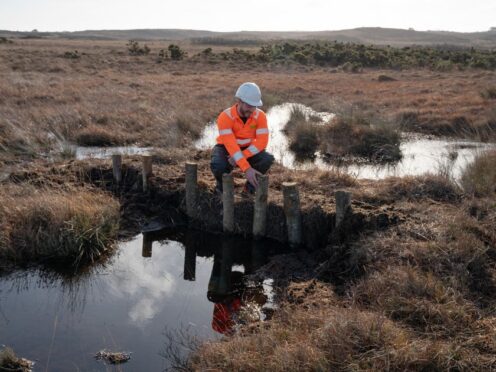Work has been launched to re-wet and restore rare peatland habitats at England’s first “super” National Nature Reserve.
The first phase of the £1 million Dorset Peat Partnership project is focussed on Agglestone Mire and Greenlands Mire near Studland in the Purbeck area of Dorset.
The peatland is one of 16 sites where it is aimed to reinstate 172 hectares (425 acres) of peatland, equivalent to the area of over 240 football pitches.
The project will involve heather bales, timber and bunds made of peaty soil being used to create “leaky dams” to block old ditches, which were originally dug to drain marshes for conifer plantations or to graze farm animals.
This will force the water to flow across the mire rather than down artificial channels.
David Brown, the National Trust’s lead ecologist in Purbeck, said: “Spreading the flow of water across the mires will create a wetter habitat where mosses and other rare plants like marsh saxifrage and tiny bog orchids can thrive.
“Under the acidic, waterlogged conditions, mosses and other plants never fully decompose, and over time they turn into new peat, which keeps their carbon locked up instead of releasing it into the atmosphere.
“Purbeck’s peat forming mires have enormous significance for rare insects, plants and other wildlife, including bog hoverflies and birds such as skylarks, as well as one of our few long-term carbon storage habitats.”
Mr Brown explained that re-wetting the mires would also improve drought and fire resilience by holding more water in the landscape during the summer, as well as helping to prevent flooding by soaking up heavy rainfall.

He said: “A new wetland ecosystem should establish itself quite quickly, providing a lifeline for many rare species that have been under threat due to the disappearance of these boggy habitats across the country.
“This includes many species of invertebrates, like the nationally rare raft spider, which floats on the bog pools and is a very aggressive hunter.
“The insects in turn attract birds and mammals, including rare nightjars that nest on the heathland and feed over the mires, and even benefit some rare plant species that grow on the peat bogs, including carnivorous plants, which rely on capturing and digesting insects to supplement their diet on the nutrient-poor bog.
“Many people don’t realise they grow in Dorset, but one is actually called the Godlingston Sundew, because it was originally found on Godlingston Heath in Purbeck.”
He added that the project would involve cutting back invasive purple moor grass, which had thrived in the face of recent droughts conditions and was threatening to smother other more delicate wetland species.
The Dorset Peat Programme, which is led by Dorset Wildlife Trust and involves Natural England, Forestry England, the Environment Agency, BCP Council, the National Trust, the RSPB and one private landowner has been funded by £787,320 from Defra’s Nature for Climate Peatland Grant Scheme (NCPGS), and £262,500 from other partners.
